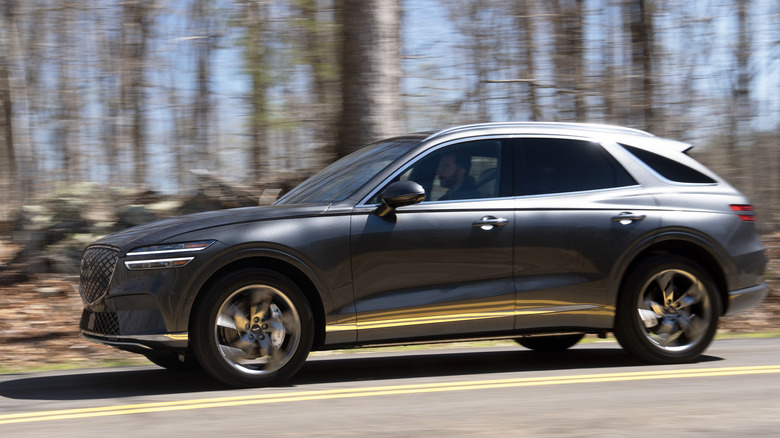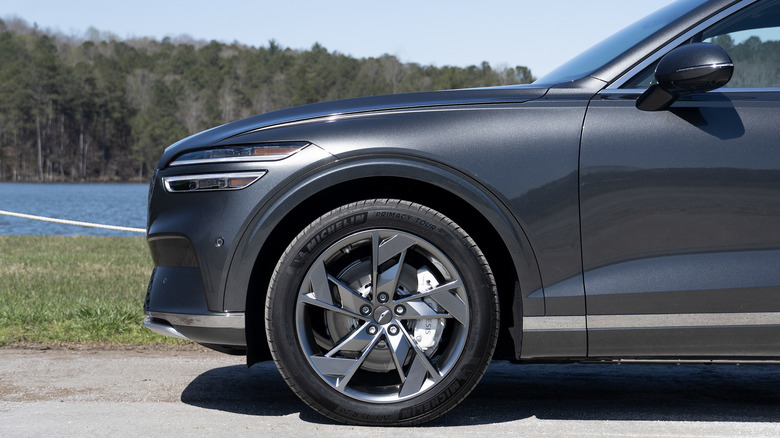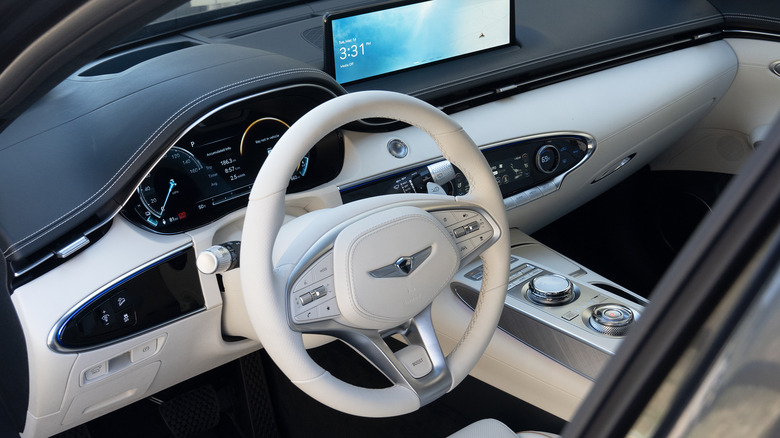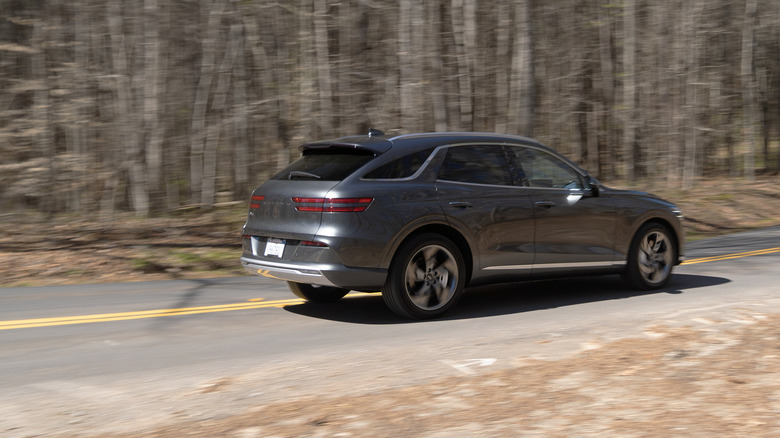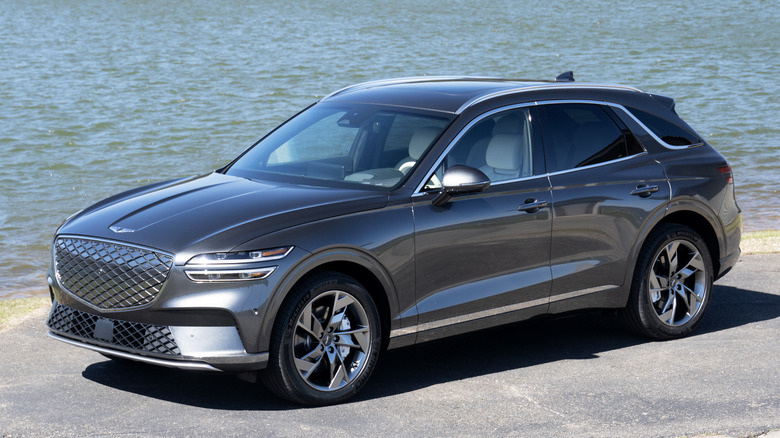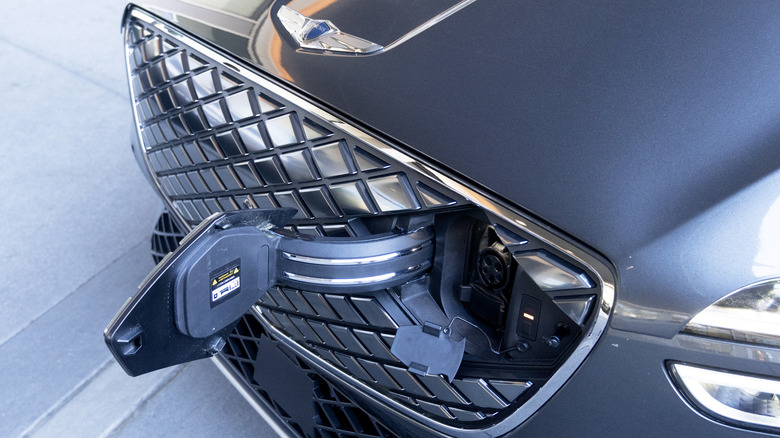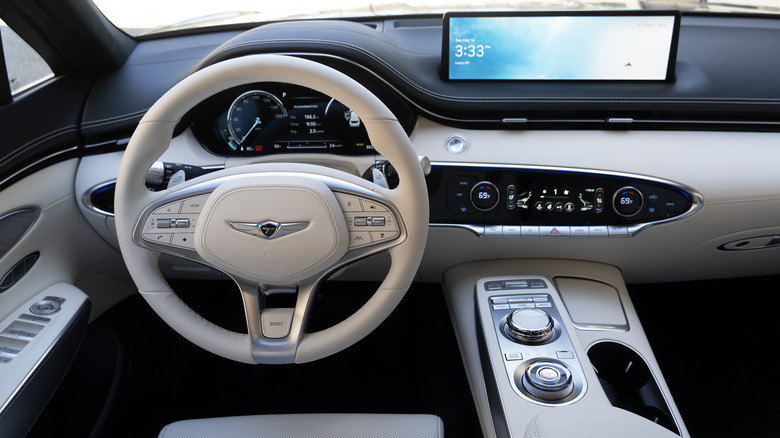2023 Genesis Electrified GV70 First Drive: City Slicker's EV Turns Heads And Hunts Chargers
Gliding along the surprisingly smooth roads of Atlanta, the new 2023 Electrified GV70 from Genesis barely turns heads during rush hour as I drive back into town from the hilly countryside. Yep, "Electrified GV70" is the official name of this new SUV, which shares almost all of a chassis, body, and interior with the original, internal-combustion GV70. From a purely experiential perspective, the GV70's opulent design and engineering ethos pairs perfectly with the silent performance of an electric motors. Only subtle exterior cues hint at the electric drivetrain swap, though: a lack of exhaust tips, skid plates, and cleaned-up fascias front and rear. The recipe follows in the same footsteps as the Electrified G80, allowing Genesis to hedge potential investment in an entirely new model by using a shared platform and dropping in a set of battery cells and motors borrowed from the fully electric GV60.
On the drive program in Georgia, Genesis also revealed the Electrified GV70's most important detail, one that will likely stick in the sales team's craw for years: an estimate range of only 238 miles. For comparison, the smaller, lighter, and EV-only GV60 can manage a little better at 248 miles, but those scant figures sound all the more surprising given that the Kia EV6 Long Range can hit 310 miles. Blame the less efficient packaging that allows for the same chassis to cradle an ICE or EV powertrain, or the GV70's heavier, less aerodynamically optimized construction, but for Genesis to get those heads turning—a major factor in mainstream recognition for a brand only five years old—the more range, the better.
All the expected specs
In place of maxed-out range, the Electrified GV70 clearly prioritizes all the other qualities that daily EV drivers will appreciate. Though ratings of 429 horsepower and 516 lb-ft of torque may not sound too peppy on paper, a Boost Mode button the steering wheel unleashes up to 482 hp for up to 10 seconds—though really, because the low-end grunt comes on instantaneously with even a slight mash of the accelerator pedal, those figures feel much more significant than might similar numbers for an ICE car. And rest assured, throughout a full day of highway overtaking and winding country roads, the Boost button received plenty of my attention.
I even tried to mimic hard launches with both Sport and Boost Mode engaged, fiddling with the traction-control settings that can switch almost fully off by holding a button to the left of the steering wheel, then flooring the gas (if we can call it that) with all my left foot's strength holding down the brake pedal. Kudos to Genesis for allowing such shenanigans in a family commuter—though side-stepping the brake only set the standard eco-focused Michelin Primacy Tour all-season tires squealing for a solid second until the traction hooked up and pressed me back into the sumptuous driver's seat. Once underway, the Electrified GV70 certainly provides those... electric... thrills (apologies, certain puns simply can't be avoided).
But much more important than hard launches off the line, which probably would have gone better with traction control at least somewhat engaged, let's turn back to those sumptuous seats, both fronts ventilated and heated with a mild massaging function that Genesis claims will increase blood flow during long road trips. (Nevermind that the car can only go 238 miles between charges, but I can report the system reduces leg fatigue climbing out after even an hour-plus of driving.)
Stellar interior carries over from ICE GV70
The GV70's interior styling also carries over with minimal changes from the gasoline-powered variant's clean and smooth dash, certainly among the best designs in the business. The choice of Obsidian Black Monotone or a two-tone Glaciar White—the latter available with contrast stitching on the Prestige trim level—keeps things simple and efficient in classic Genesis fashion. A row of tactile piano-key controls sits below the central climate control screen, with a 14.5-inch touchscreen atop the dash that allows for Apple CarPlay and Android Auto connectivity.
Every detail, inside and out, caters perfectly to the urban creative that Genesis hopes will make up the market for the company's latest EV. And just about every one of those theoretical customers will use an iPhone to conduct important transcendental business meetings on the road, right? So perhaps most importantly, the Electrified GV70 provides what no gas-powered SUV can manage: silence.
Or at least something like it. The silky drivetrain emits only a slight whine during acceleration, and additional insulation below the cabin helps to eliminate just about any hint of road and tire noise that the relatively low-profile Michelins on 20-inch wheels might otherwise channel directly into the cabin. The road itself, meanwhile, vaporizes into a cloud of marshmallows thanks to an incredible electronic suspension system with a "Road Preview" camera that adjusts damper stiffness on the fly.
Differences between ICE and EV
While cruising, I melted into the cushiony seats and found inner peace listening to French electronic music. But when the traffic cleared up and the rolling hills opened wide, switching into Sport mode revealed even more of the suspension's full capabilities. A couple of the main engineering differences between the ICE and electric GV70 variants include a revised sway bar with different mounting points to make room for battery packaging, as well as "Hydro G" bushings that further absorb road imperfections. The combination allows for perhaps a bit more body roll than on most other EVs, which manufacturers tend to overly tighten up in the hopes of accentuating the benefits of lowslung skateboard weight distribution. The effects of such sportiness can sometimes create a sensation best described as "rafting" during aggressive maneuvers, but despite additional aluminum and carbon-fiber bracing compared to its gasoline sibling, the Electrified GV70 avoids such tendencies.
Part of the performance can likely be attributed to the fact that this EV only weighs around 600 pounds more than its gasoline version. That's just over 10% of a total curb weight right around 5,000 pounds, but the electric motors far eclipse even the higher-spec GV70's twin-turbo V6, which puts down "only" 375 horsepower and certainly requires winding up well above a single RPM to enter its peak torque rev range.
Maserati managed to avoid rafting effects in the electric Folgore version of the forthcoming GranTurismo by mounting the batteries in a longitudinal "dogbone" layout. And similarly, Maserati seems focused on hedging any EV bets by offering a gasoline and full-EV version of the GranTurismo—no hybrid middleground, same as the GV70. But now I'm comparing a Genesis, from the luxury spin-off company that shares components with budget-friendly commuters from Hyundai and Kia, against a $200,000-plus borderline supercar. Not bad, given the GV70's starting sticker of $65,850.
Attempting a Tesla takedown
Perhaps a more apt comparison might be the Mercedes-Benz EQB, which offers between 227 and 250 miles of range depending on spec while starting nearby in the high $50,000s. Or the BMW i4, at closer to $55,000 and the iX, which costs about $20,000 more than the GV70. True comparables from legacy luxury automakers remain scant at this time, but of course, Genesis needs the Electrified GV70 to aim squarely at Tesla's Model Y and X. While Tesla's battery and motor tech allows for well-tested range estimates currently well above 300 miles, build quality concerns and Twitter feuds definitely fit into any potential buyer's considerations—established EV vets and newcomers alike.
The marketing strategy from Genesis therefore needs to paint with a large brush, but this is a brand on the up-and-up, having sold 56,410 units in 2022 and well into the liminal electric phase after introducing the lineup's first full EV less than a year ago in May of 2022. More sales means more cars on the road means fewer occasions where consumers wonder what, exactly, they're looking at—as I witnessed multiple times alone at Monterey Car Week this past summer, when more than two people commented to me how much they liked the Aston Martin on the Concept Lawn, which was actually a Genesis. Six-figure supercars being compared to an affordable luxury brand, this time in design terms, not bad.
Anyone who drives the Electrified GV70, though, will come away duly impressed by every aspect other than range. A few minor complaints emerged during a full day around Atlanta, mostly that the touchscreen glitched out a few times when using Google Maps on Apple CarPlay for navigation, requiring me to unplug my iPhone and then plug it back in (wireless CarPlay is a frustrating omission). The I-Pedal regenerative braking system defaults to two-pedal driving every time the car turns off and then back on again, too. But at least this EV comes with an on-off button, unlike many others with which I have spent inordinate amounts of time trying to decipher whether the music keeps playing when I walk more than 50 feet away with the doors locked.
Range stats require a lifestyle shift
Those range concerns do stick around, though. Genesis promises three years of free 30-minute charging at Electrify America stations nationwide, claiming a potential 18-minutes for a 10-80% charge. On an 800-volt ultra-fast charger, the GV70 can even add 64 miles of range in only five minutes—but then you have to find such a thing, first.
Genesis reps also sounded confident that, because every Electrified GV70 destined for the American market will be built here in America, customers will be able to qualify for federal tax rebates under the Inflation Reduction Act of 2022. So a loaded Prestige that stickers for $72,650 and up, equipped with Nappa leather upholstery, a suede headliner, heated second-row seats, and a nifty (if hilariously unnecessary) 12.3-inch 3D gauge cluster might well sound even better compared to a Model Y Performance. But keep in mind that the Tesla Model S debuted over a decade ago with 260 miles of range. And the forthcoming Lucid Air Pure, with one of the most spacious and luxurious interiors of any car ever, will also offer 410 miles of range.
Maybe Genesis hopes that by the time potential EV buyers turn to the Electrified GV70 en masse, charging network issues will resolve and (currently very real) range anxiety concerns will fade. Such developments will likely help to woo those first-time buyers, even if the 238 mile range currently caters better to previous EV owners accustomed to the lifestyle shift that charging still requires at the moment.
Real-world driving in style and comfort
Electric cars by Genesis will eventually arrive at dealers in 15 states (CA, AZ, CO, CT, LA, MA, MD, NV, NJ, NY, TX, UT, VA, WA, WI), another annoyance compared to more widely-available EVs. Meanwhile, deliveries of the earliest orders should begin any day, as the first production cars rolled out of the shared Hyundai and Genesis plant in Montgomery, Alabama, before I even arrived in Atlanta.
Battling traffic back into town, I played around with the respectably smooth Highway Driving Assist II suite of semi-autonomous driving features while keeping an eye on my remaining range. After just under 160 miles of entirely injudicious driving, the Electrified GV70 reported just over 170 miles of range consumed. Again, not bad for a full day of comfortable cruising interspersed with hard launches and plenty of Boost Mode. Not bad at all.
